Embarking on a ketogenic journey is more than just a change in diet; it's a transformation that impacts your entire lifestyle. One of the key debates in the keto community revolves around the pace of this transition. Is it more effective to adopt a slow and steady approach, or should one dive headfirst into the depths of ketosis? In this blog, we'll explore the nuances of the keto transition, considering both approaches and shedding light on the importance of continuous ketone monitoring, particularly with SiBio's groundbreaking technology.
Understanding the Keto Transition
The keto transition is a process where the body shifts from using carbohydrates as its primary fuel source to burning fat for energy. This shift can come with a range of experiences, from increased energy levels to the infamous keto flu. Many individuals approach this transition with the question: Is it better to ease into ketosis gradually, or should one make a swift, decisive change?
The Slow and Steady Approach
Advocates of the slow and steady approach argue that a gradual reduction in carbohydrate intake allows the body to adapt more comfortably. By slowly decreasing carbs over a period of time, the body has the chance to adjust its metabolic processes without the shock of a sudden dietary overhaul. This method may be particularly appealing to individuals concerned about potential side effects like the keto flu.
The Swift Dive into Ketosis
On the other side of the spectrum, some argue that a rapid transition into ketosis can yield faster results. By significantly reducing carb intake from the get-go, the body is forced to rely on fat for fuel sooner. Proponents of this approach often claim that the faster transition minimizes the duration of discomfort associated with the adjustment period.
When to Choose the Slow and Steady Approach:
1. Beginners to Keto: If you're new to the ketogenic lifestyle, easing into it gradually can be beneficial. This approach allows your body to adapt at its own pace, minimizing the risk of overwhelming symptoms associated with the keto flu.
2. Minimizing Discomfort: Individuals who are concerned about potential side effects such as headaches, fatigue, or irritability may find the slow and steady approach more manageable. It gives your body time to adjust, reducing the intensity and duration of discomfort.
3. Lifestyle Integration:Those with busy schedules or social commitments might prefer a gradual transition. It allows for a more seamless integration of the keto lifestyle into your daily routine without causing disruptions.
When to Opt for the Swift Dive into Ketosis:
1. Experienced Keto Individuals:If you've been on the ketogenic diet before or have experience with low-carb eating, a swift transition may be suitable. Your body might adapt more quickly to using ketones for fuel.
2. Quick Results: Individuals looking for rapid results, such as those aiming for fast weight loss or seeking immediate improvements in energy levels, may find the swift dive into ketosis appealing. The quicker transition can lead to faster ketone production.
3. Motivation and Commitment: Some individuals thrive on the immediate commitment of a strict dietary change. If you find that diving into a new lifestyle headfirst boosts your motivation, a swift transition might be the right choice.
SiBio KS1: Guiding You Through the Transition
Regardless of the approach you choose, the SiBio KS1 Continuous Ketone Monitoring Sensor is a valuable companion on your keto journey. This innovative technology offers real-time insights into your body's ketone levels, providing a deeper understanding of how your metabolic state evolves during the transition.
Imagine having the ability to monitor your ketone levels continuously for up to 14 days, gaining insights without the need for constant fingersticks. The SiBio Ketone Sensor is not just a monitoring device; it's a bridge between your dietary choices and their impact on your metabolic health.
Why Continuous Ketone Monitoring Matters
Continuous ketone monitoring eliminates the guesswork from the keto transition. Whether you opt for a slow and steady approach or a swift dive into ketosis, having real-time data allows you to fine-tune your dietary choices. The SiBio Ketone Monitor ensures you stay in the optimal ketone range, helping you make informed decisions about your food intake, exercise routine, and overall lifestyle.
Conclusion: Navigating the Keto Transition with Confidence
In the journey toward ketosis, there isn't a one-size-fits-all approach. Whether you choose to take it slow and steady or embrace a swift transition, the key is to listen to your body and make adjustments accordingly. With the SiBio KS1 CKM by your side, you have a reliable tool that empowers you with continuous insights, making the keto transition a personalized and informed experience.
In the end, the best approach to the keto transition is the one that aligns with your preferences, goals, and lifestyle. Whichever path you choose, SiBio is here to guide you through the intricate journey of ketosis, ensuring that you navigate the transition with confidence and clarity.
FAQ:
Q: Can I Combine Slow and Fast Transition Methods for a Hybrid Approach?
A: Absolutely! A hybrid approach, combining elements of both slow and fast keto transition methods, offers flexibility and customization. Start by gradually reducing carb intake to allow your body to adapt comfortably. As you progress, consider implementing intermittent fasting or brief periods of more aggressive carb restriction for a faster boost into ketosis.
Q: Can I Revert to a Regular Diet After Completing the Keto Transition?
A: Certainly! After completing the keto transition, you can reintroduce carbohydrates into your diet. However, it's crucial to do so mindfully and gradually. Sudden reintroduction may lead to weight regain and potential disruptions in metabolic health. Consider maintaining a balanced, whole-foods-based diet to sustain the benefits gained during the keto transition while incorporating a moderate amount of carbohydrates based on your individual needs and preferences.
Q: Is Rapid Weight Loss Inevitable with a Swift Transition?
A: While some individuals may experience rapid weight loss during a swift keto transition, it's not guaranteed for everyone. The pace of weight loss varies based on factors like metabolic rate, adherence to the diet, and overall health. While a swift transition can kickstart fat burning, individual responses differ, and sustained weight loss requires a combination of dietary adherence, physical activity, and metabolic factors.








